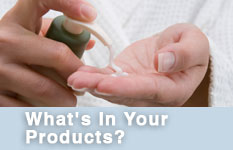 Public health laws allow:
Public health laws allow:- Almost any chemical as an ingredient in personal care products
- Misleading and incomplete labeling of ingredients
- Unsubstantiated claims about product benefits
- No required safety testing of products or ingredients
What can you do?
Navigating store aisles can be difficult. Environmental Working Group researchers have evaluated hundreds of safety studies and thousands of ingredient labels to bring you our top recommendations for what not to buy.
- Pick safer products
- Your body
- Your teeth
- Your lips
- Your skin + the sun
- Your hair
- Your nails
- Your kids
- For babies and young children
- For teens
- For women
- For men
- Over-the-counter drugs and personal care products
- Buyer beware: Less common ingredients with significant health concerns
- Ingredients derived from animals
Pick safer products:
Use EWG’s Skin Deep Cosmetics Database to find safety scores for thousands of products.
Print our wallet guide
Use fewer products. Buy only after reviewing ingredients.
Remember marketing claims like “dermatologist-tested,” “gentle” and “natural” could be ad hype.
Getting clean
No { triclocarban (bar soap) or triclosan (liquid soap) }
Yes { hand sanitizers with ethanol/ethyl alcohol }
Moisturizing
No { retinyl palmitate or retinol in daytime skin products }
No { triclosan in toothpaste }
No { retinyl palmitate or retinol }
Very few sunscreens provide adequate sun protection and are free of harmful ingredients.
No
SPF above 50
Retinyl palmitate
Aerosol spray and powder sunscreen
Oxybenzone
Insect repellent
Yes
Hats and shade in mid-day sun.
Zinc or Titanium are the best active ingredients, otherwise Avobenzone at 3%
SPF 30 for intense sun
Use a lot and reapply frequently
No
Fragrance
PEGs, ceteareths and polyethylene
Parabens: propyl, isopropyl, butyl, isobutyl
DMDM hydantoin
No
Formaldehyde or formalin in polish, hardeners or other nail products.
Toluene
Dibutyl phthalate (DBP).
Pregnant? Skip polish
Kids are sensitive. Use few products and pick them carefully.
Diaper Cream
No Boric Acid
Baby Wipes
No 2-Bromo-2-nitropropane-1,3-diol (bronopol)
Toothpaste
LIMIT fluoride toothpaste for kids who might swallow it (none for kids under 2)
5 problem products:
Some categories of products have major safety concerns. Avoid them, particularly for children.
Hair straighteners : cancer, allergy, skin and scalp irritation, hair damage and hair loss
Loose powders: inhalation risk
Perfumes/fragrances: allergy concerns
Dark permanent hair dyes: linked to cancer
Skin lighteners: skin irritation and damage
Common ingredients with safety concerns:
“Fragrance“: This catch-all term can include hundreds of chemicals and trigger allergic reactions. Skip products that use the term “fragrance” in the list of ingredients and instead opt for those that list each fragrance ingredient.Ingredients can have harmful contaminants: Many common ingredients can contain impurities linked to cancer and other health concerns. Avoid these common ingredients where possible:
- DMDM hydantoin,
- Diazolidinyl urea,
- Imidazolidinyl urea,
- Ceteareth,
- Polyethylene glycol and PEG
For a full list of ingredients with impurities concerns, check EWG’s Skin Deep database.
In depth: common ingredients to avoid
Benzalkonium chloride: Biocide, preservative and surfactant associated with severe skin, eye, and respiratory irritation and allergies, benzalkonium chloride is a sensitizer especially dangerous for people with asthma or skin conditions like eczema. It is found in many household disinfectants and cleaning supplies. Regular use of products containing antimicrobials such as benzalkonium chloride could lead to development of resistant bacteria.
BHA: The National Toxicology Program classifies butylated hydroxyanisole (BHA) as “reasonably anticipated to be a human carcinogen.” It can cause skin depigmentation. In animal studies, BHA produces liver damage and causes stomach cancers such as papillomas and carcinomas and interferes with normal reproductive system development and thyroid hormone levels. The European Union considers it unsafe in fragrance. It is found in food, food packaging, and personal care products sold in the U.S.
Coal tar hair dyes and other coal tar ingredients (including Aminophenol, Diaminobenzene, Phenylenediamine): Coal tar, a byproduct of coal processing, is a known human carcinogen , according to the National Toxicology Program and the International Agency for Research on Cancer. Hair stylists and other professionals are exposed to these chemicals in hair dye almost daily. While FDA sanctions coal tar in specialty products such as dandruff and psoriasis shampoos, the long-term safety of these products has not been demonstrated.
DMDM hydantoin & bronopol (2-Bromo-2-nitropropane-1,3-diol): Cosmetics preservatives that decompose and release formaldehyde , which the International Agency on Research on Cancer lists as a known human carcinogen. The preservatives and their decomposition products, including formaldehyde, can trigger allergic reactions. About one-fifth of U.S. cosmetics and personal care products contain a chemical that releases formaldehyde. Not surprisingly, more Americans develop contact allergies to these ingredients than Europeans.
Formaldehyde: A potent preservative considered a known human carcinogen by the International Agency on Research on Cancer. Formaldehyde, also an asthmagen, neurotoxicant and developmental toxicant, was once mixed into to many personal care products as antiseptic. This use has declined. But some hair straighteners are based on formaldehyde’s hair-stiffening action and release substantial amounts of the chemical. Many common preservatives also release formaldehyde into products (like DMDM hydantoin, quaternium, and urea compounds).